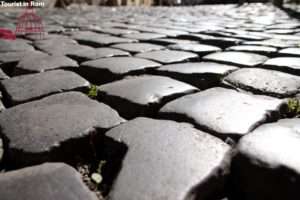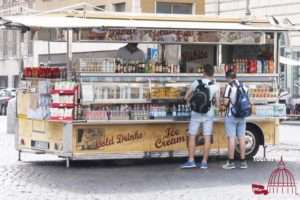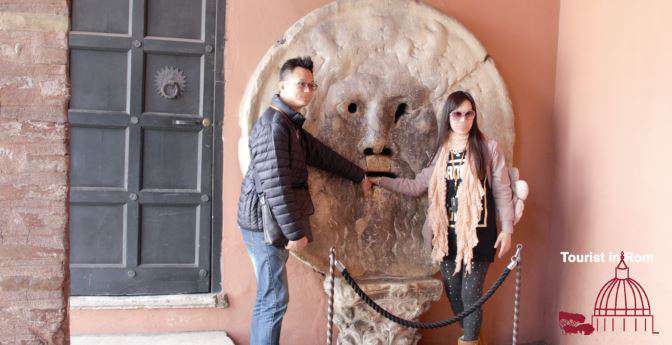When in Rome, don’t do what the Romans don’t do. This is how one could interpret the story that Augustine wrote more than 1600 years ago and that still holds true today.
Rome, the Eternal City, attracts visitors with its ancient buildings, art treasures and delicious cuisine. Not only is Rome the birthplace of our laws and modern calendar, but ancient customs and traditions are still alive today. Immerse yourself in Roman life without putting your foot in your mouth by following these 10 important “don’ts” in Rome:
Museums
Don’t visit the most important museums without a reservation: If you embark on a cultural tour of Rome without a reservation, you may spend more time waiting in line than enjoying the art. Especially for the Colosseum, the Vatican Museums with the Sistine Chapel, and the Borghese Gallery with its exquisite collection, a reservation is not only recommended but essential. Reservations allow easy access to the museums at the reserved time. Booking in advance is the key to seeing Rome’s masterpieces.
Rome by foot
Don’t walk the entire city: Many of the city’s many downtown attractions are best explored on foot. But trying to explore the entire city on foot is a Herculean task that is more likely to result in exhaustion than enthusiasm. Exploring everything on foot quickly becomes exhausting, as it can add up to 15 miles a day. Explore the city on hop-on-hop-off buses, enjoy a city tour in an electric vehicle, or use the Moovit app to find the best public transport connections. Pay on the bus with your credit card and if you take more than one trip, you’ll pay not more than the one day ticket price. Rent a bike or take a taxi once in a while to save your energy for when you really need it.
Dress code

Don’t wear beach clothes in Rome: Even on hot days, don’t walk around Rome dressed too lightly to avoid attracting unwanted attention. Good shoes are also a must, as you will be walking around the city a lot. In the holy places, such as St. Peter’s Basilica, the Vatican Museums and the Catacombs, the dress code must be observed. The general rule applies to both men and women: Shoulders and knees must be covered or you will not be allowed in. This means no sleeveless tops, shorts or miniskirts. Failure to comply with these rules may result in you being denied entry and not being able to enjoy the serene beauty and historical richness of these places. So bring a scarf if you are off-the-shoulder and wear at least knee-length pants or skirts.
Snack vans

Do not buy from food trucks or so called minimarkets: If you’re on the road for a long time, you’ll want to take a break to eat or drink something. Many bars and street food stalls offer good quality food. However, avoid the food trucks that are located near many sights and offer mediocre quality at inflated prices.
Vendors, especially near the Colosseum, offer refilled bottles of water that look like they just came out of the fridge. Mini-markets, which are open late into the night and offer their goods at inflated prices, should only be visited in an emergency. You can buy water, fruit and other snacks at cheaper prices at local grocery stores or supermarkets. It is also a good idea to have a plastic bottle with you, which you can fill at one of the many public drinking fountains in the city, the “nasoni”. There are also some public water fountains where you can even get chilled sparkling water for free.
Touristic restaurants
Don’t eat at tourist restaurants: Tourist restaurants are usually easy to spot. There is often someone standing in front of the restaurant advertising it and extolling its virtues. Many restaurants also advertise with colorful posters or plastic dummies of the food. Other restaurants are highly praised on social media, and there are often long lines. Many of those who post reviews have no idea about authentic Roman cuisine and there is a high risk that these are mass-produced dishes of mediocre quality. Before ordering, you should also check whether the price list includes a percentage service charge or a charge per seat. The service charge is hard to justify. The actual price should be listed on the menu, not a price to which a percentage is added. The situation is somewhat different with the seat charge, the so-called “coperto” for the table setting. The “coperto” has a long tradition. Some diners order just one plate, others two antipasti, a starter, a main course and a dessert. If the coperto is not charged separately, each plate is more expensive. If you order several dishes, you pay the coperto several times. If you don’t like being charged for the coperto, find a restaurant that doesn’t charge it separately.
Cappuccino after a meal
Do not order a cappuccino after a meal: A coffee with milk, such as a cappuccino or latte macchiato, is traditionally drunk for breakfast in Rome, along with a pastry made from yeast dough or puff pastry. Drinking a latte after a meal is beyond the imagination of the Romans. After a good meal, a good espresso is said to aid digestion. A large cup of caffè latte is said to have the opposite effect. Even the double espresso should only be ordered after a night of drinking, with salt and lemon, as any barista will understand.
Respect Monuments
Do not damage monuments: Rome’s historical monuments and ancient ruins are treasures that deserve to be respected and preserved for future generations. Unfortunately, damage and soiling do occur, such as chewing gum and ketchup on the Spanish Steps. Eating or sitting on the steps is therefore strictly forbidden. You should also not immortalize yourself with graffiti on sights such as the Colosseum. This will quickly land you in the newspapers and a Roman police station. The historic fountains have also been damaged, so keep your distance and don’t jump in, even on hot days. Help keep Rome beautiful by leaving no damage and taking only unforgettable memories.
Street Vendors
Do not let people approach you! Although Rome is generally safe, there are always small scams that target unsuspecting tourists. Beware of people who try to engage you in conversation or offer you goods, water or tickets. The best thing to do is to ignore them and move on. Otherwise it can be difficult to get rid of them. Take only what you need and keep it safe.
Taking photos
Do not use a tripod to take pictures: It is forbidden to take pictures with a tripod in Rome. It is considered an occupation of public property if you do not have a permit. It is also forbidden to launch drones without permission. It is also forbidden to photograph critical infrastructure such as train stations or airports, as well as police and military personnel.
Sometimes carnies pose as gladiators or legionnaires and you can have your picture taken with them. However, the price should be agreed upon beforehand, otherwise excessive demands and disputes can easily arise.
Cash machines
Do not use private ATMs: You need cash for a coffee in a bar, an ice-cream or a tip in a restaurant. Otherwise, you can pay for everything in Rome with a credit card. You can get cash at many ATMs, but you should only use those located in bank branches. Other ATMs, often located outside shops, charge high fees for withdrawing cash. The machines often offer conversion to the local currency. However, it is usually cheaper to have your bank do the conversion.
Bonus tip: Don’t overdo it in Rome. Let yourself go and enjoy the Roman way of life.
By following these tips, you’ll be well equipped to navigate Rome like a Roman, avoiding common pitfalls and enjoying the best the city has to offer. So lace up your walking shoes and get ready for unforgettable days of history, culture and food.


